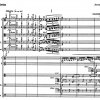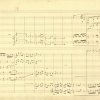Sinfonietta
Sinfonietta for two string orchestras (1956)
{slider=Sinfonietta for two string orchestras. Allegro /fragment/}
Polish Radio Symphony Orchestra, cond. Krzysztof Słowiński, Warsaw 2003
{/slider}
{slider=Sinfonietta for two string orchestras. Adagio /fragment/}
Polish Radio Symphony Orchestra, cond. Krzysztof Słowiński, Warsaw 2003
{/slider}
{slider=Sinfonietta for two string orchestras. Vivace /fragment/}
Polish Radio Symphony Orchestra, cond. Krzysztof Słowiński, Warsaw 2003
{/slider}
It is the second – after Suite of Preludes – example among Serocki’s works of early experiments with the twelve-note technique. The motivic material of the piece is constituted in the first of its three movements – Allegro. It is made of a fourth-based motif, emerging already at the beginning of Allegro, an expansive melody (dolce ma espressivo) serving as the second theme as well second-based and third-based motifs making up various runs and “embellishments”. They appear further on in the composition – part two: Adagio and three:Vivace – giving it considerable coherence. The work thus heralds an experimental trend in Serocki’s work in subsequent years (also with regard to the spatiality of music, for it is written for two orchestral ensembles, and the composer skilfully uses the possibilities offered by this kind of disposition). On the other hand, it can be seen as telling evidence of neo-classical style: when it comes to its form (part one is the sonata form, part two – passacaglia, part three – sonata rondo), cheerful mood as well as clarity, lucidity of truly virtuoso sound.
{slider=Sources:}
- Tadeusz A. Zieliński,O twórczości Kazimierza Serockiego [On Kazimierz Serocki’s Oeuvre], Kraków 1985.
{/slider}
Sheet music available from: PWM









